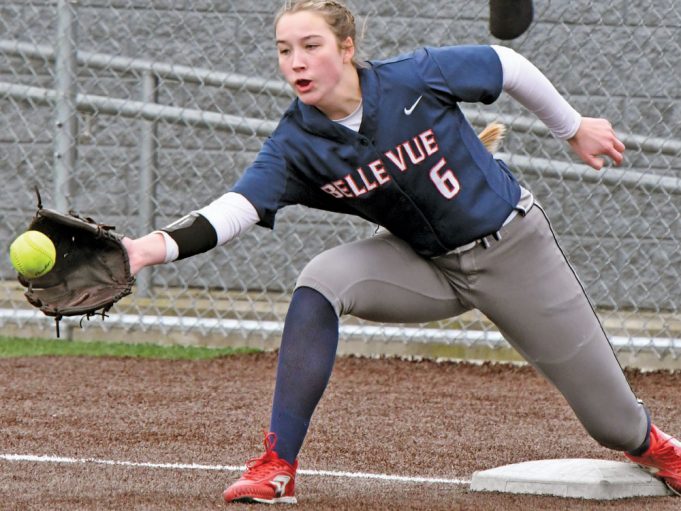Obstruction is a common occurrence in softball. It happens most often at home plate as catchers try to prevent a runner from scoring. However, it does happen quite a bit on the basepaths as well. And one of the places it happens that can cause confusion is on an initial play at first.
If you think about the number of plays at first base in a game, the chances are actually pretty high that a bad throw or poor footwork will lead to potential obstruction in every game. Some fielders are very adept at moving their feet in order to avoid obstructing, but that is not always the case. So how do umpires judge if obstruction has occurred?
First, let’s take a look at the rules regarding obstruction. All four codes define obstruction in relatively the same fashion. Obstruction occurs when a defensive player, neither in possession of the ball nor in the act of fielding a batted ball, impedes the progress of a runner who is legally running the bases on a live ball (NFHS 2-36, 8-4b; NCAA 9.5; USA Softball 8-5b, R/S 36; USSSA 3 – Obstruction, 8-13). NCAA rules go a little further by stating it is obstruction if a defensive player is blocking the whole base or basepath without the ball and/or the runner does not have a path to the base.
While most first basemen take the throw from the side of the bag facing the infield, or at least on one of the corners of that side, sometimes footwork or a poor throw causes the fielder to move. For example, in the photo above, the first baseman has her left foot on the back corner of the bag instead of the front corner. This causes her entire leg to be blocking the front portion of the base. Because of this positioning, she is susceptible to being called for obstruction.
In NFHS, USA Softball and USSSA, just being in that position in and of itself does not constitute obstruction. She still must impede the runner. If the umpire judges the fielder impeded the runner — caused the runner to slow down, change her path or alter her running in any way — obstruction would be ruled. The umpire should give the delayed-dead-ball signal and continue to adjudicate the play. If the runner arrives ahead of the throw, the ball would remain live and play continues. If the runner is put out, the umpire should call time and award the batter-runner first base.
If the fielder catches the ball prior to the runner getting to the base and the umpire rules the fielder did not impede the runner, the batter-runner would be ruled out.
In games using a double first base, umpires must also determine which bag the fielder is blocking and which base the runner is attempting to touch, and if those players have the right to be at those specific bags, which could complicate matters even more. In this particular play, the throw is not offline, so the fielder would not have a right to use the colored portion of the bag and the runner would not have the right to go to the white portion.
In NCAA, if the umpire judges the fielder is blocking the entire base or the entire basepath, obstruction is called, regardless if the runner alters her path. The act of blocking the entire base or basepath in and of itself is obstruction. If the runner is clearly beaten by the throw, the runner would be ruled out. If the runner is not clearly beaten by the throw, such as in the play above, the runner would be awarded first base. The NCAA defines clearly beaten by the throw as “at the time the fielder catches the ball, it could not be reasonably expected for the runner to begin their slide, or the runner is out by such a significant margin that the fielder must wait for the runner to arrive to apply the tag or until they give themself up. It should be a relatively infrequent call. Do not confuse this with a runner being ‘clearly out.’ It’s important to note that ‘clearly beaten by the throw’ ONLY applies to obstruction for blocking the whole base or base path (AR 9-13).”
In situations where the fielder blocks the bag, chances are a collision will occur as the ball and runner arrive at the same time and the fielder is unable to get out of the way (and the runner is unable to avoid contact). In these cases, it is important for umpires to make sure there is nothing malicious in the contact (a raised forearm, a hard shove, etc.). A runner putting her arms up to protect herself is natural and should not be deemed malicious contact.
In these instances, the base umpire has the first responsibility to judge the potential obstruction. However, a plate umpire trailing the runner up the first-base line also can assist with this call as that umpire may have a better look to see if the fielder is blocking the entire base or basepath and also see if the runner deviates. Umpires should work together to get this call right and help clean up plays, and potential collisions, at first base. The game is better, and safer, without them.
What's Your Call? Leave a Comment:
Note: This article is archival in nature. Rules, interpretations, mechanics, philosophies and other information may or may not be correct for the current year.
This article is the copyright of ©Referee Enterprises, Inc., and may not be republished in whole or in part online, in print or in any capacity without expressed written permission from Referee. The article is made available for educational use by individuals.

















